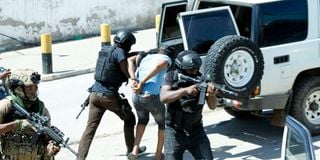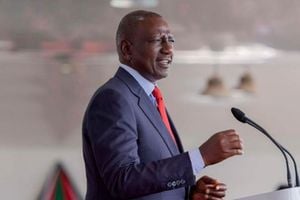
Smoke billowing up after the first of the two towers of the World Trade Center collapses in New York City during the terror attack on September 11, 2021.
| File | Henny Ray Abrams | AFPNews
Premium
How the global war on terror changed Kenya
Tuesday, September 11, 2001. Nairobi. “Ghai’s radical plan for times of change,” reads the Daily Nation headline, in reference to proposed constitutional amendments.
It is only 15 months to the general election.
After 23 years in power, President Daniel Moi has declared he won’t defend his seat as he is term-limited by the Constitution. Ruling party Kanu is disintegrating. The opposition has not settled on the candidate to front.
Other than the din of succession politics, the country is enjoying a period of calm.
But something dreadful is about to happen some 12,000 kilometres away in the US, which would rouse the country, and forever change the landscape of security in Kenya, Africa and the world.
In a space of 100 minutes, Al-Qaeda terrorists carry out a series of coordinated attacks, hijacking four commercial flights, and crashing two at the World Trade Centre in New York, one at Pentagon and the fourth in Pennsylvania.
Scarred for life
When the dust settles, 2,996 people are dead. Thousands are wounded and millions scarred for life.
In the intervening months, US troops will invade Afghanistan to flush out Taliban which has defied demands to eject Al-Qaeda jihadists from their territory.
The war on terror is on.
But how did the war on terror change Kenya and the world? How has security within Kenya’s borders changed? In what ways has the government’s approach to terror changed over the last two decades?
With the US strictly sealed, security checks heightened and visitors scrutinised at all points of entry, a similar attack on US soil was going to be virtually impossible. Terrorists, though, changed their tack — they would now target US citizens wherever they are in the world.

Former US President George W. Bush speaks during a 9/11 commemoration at the Flight 93 National Memorial in Shanksville, Pennsylvania on September 11, 2021.
US ally
But not just US citizens. Jihadists were also going to hit all friends of the US globally. Being a strategic ally of the US in the Horn of Africa, Kenya became roped in the war.
When the Kenya government declared war on terror, jihadists started to strike the country sporadically, with more than 500 casualties. There was never turning back.
Five of the deadliest terror attacks in Kenya have occurred during the tenure of President Uhuru Kenya, namely Muthurwa, Westgate Mall attack, Garissa University, El Adde and dusitD2.
In 2016, President Kenyatta said Kenya was considering building a facility similar to Guantanamo Bay to hold convicts of violent extremism, “to keep them from spreading poison” to other inmates, though there has been no follow up of the plan. That is how the government has been committed to tackling terror.
In the same fashion that US forces invaded Afghanistan, KDF's 2011 incursion into Somalia was motivated by the growing threat posed to Kenya's security by the Al-Shabaab insurgents whose origin and base is in the Horn of Africa country.
For 10 years now, KDF has fought alongside African Mission in Somalia (Amisom) troops to neutralise the criminals, with hundreds casualties.
When Kenyan military moved into Somalia, then KDF Chief of Staff Gen Julius Karangi famously noted that “there's no war without casualties”.
While Kenya and the US have for years lobbied the international community to designate al Shabaab a terror group, the United Nations Security Council has been hesitant. The UN argues that doing so would compromise aid work and other missions in Somalia.
Security budget
Today, national security and defence receive one of the largest proportions of the country's budget. In the current financial year, for instance, Treasury allocated this docket about Sh294.5 billion, to be distributed to the National Police (Sh110 billion), Kenya Defence Forces (Sh119 billion) and National Intelligence Service (Sh42.5 billion).
In Kenya, Defence is among the five ministries with the highest budget allocations. This money goes to recruitment, training and remuneration of personnel and for acquisition of equipment.
In front of the main building of Thika Road Mall, barriers line the entrance, creating a buffer between the driving lanes and the main building. To the casual eye, these structures may pass for aesthetic fixtures. Except these are security features for blocking motorists from driving into the mall.
With rogue motorists driving into crowds in cities across the world, architects in Kenya are leaving nothing to chance.
Such is the situation across all public places in Kenya.
At the entrance of Jomo Kenyatta International Airport (JKIA), a lot has changed over the years. From the main gate three kilometres away, security checks have been taken several calibrations higher. Here, passengers disembark and walk through a security screening booth as vehicles are inspected.
But it is inside the airport where passengers are taken through even more rigorous checks at multiple stages before boarding. During the entire process, armed police officers, both uniformed and undercover, survey the installation lest any threat emerges. To enhance surveillance at East Africa’s largest airport are hundreds of cameras installed at all points.
The checks are replicated across all airports and airstrips in Kenya, making air travel one of the safest in the country.
Tough job
When he reports to work every morning, Nicholas Bett knows a day that starts well could go fatally askew, putting his life and those of the people he guards in danger. Bett is part of a 25-man team that guards a key building along Kimathi Street in Nairobi. His day starts with a briefing parade and ends in a debriefing with his supervisors, where the state of security of the building is assessed and the team notified of possible threats.
“Nobody is allowed to access the building without going through the necessary checks. We scan for firearms and other dangerous objects that could be used to harm occupants,” Bett explains, noting that his is a tough job that gets even more complicated when the threat of attack in the country is reviewed upwards.
While some of his colleagues man the scanner, others frisk people entering the facility. Another group patrols the vicinity to detect adversity.
The demand for security for buildings in Kenya has been on a steady rise in recent years, to respond to growing terror threats. There are about 2,000 private security firms in the country who hire hundreds of personnel.
Managements of buildings are spending a fortune to hire security firms to protect users. With this demand has been a growing need to train and certify firms and their personnel.
In 2019, the Kenya Private Security Workers’ Union required these firms to be vetted and to comply with the new Private Security (General) Regulations, gazetted by Interior CS Dr Fred Matiang’i in July 2019.
In the last 20 years, the government through its various security apparatuses has heightened surveillance within Kenya’s territory to protect the country from invasion by both internal and external terrorists.
While Kenyans go to sleep and go about their every-day activities, the country’s spies, drawn from both military and police intelligence services, are always vigilant. Some of the intelligence gathered by these men and women has helped to thwart terror attacks, prevent loss of life and led to the arrest of terror suspects.

Police arrest two terror suspects at the Likoni crossing channel in Mombasa on August 23, 2021.
Likoni terror suspects
In the latest incident, detectives arrested in August two terror suspects at the Likoni Crossing Channel as they transported rifles, machetes and explosive-manufacturing paraphernalia.
Detectives say the equipment had been shipped into the country from the Democratic Republic of Congo (DRC) through Kenya’s border with Tanzania in Kwale County.
The terrorists had been in the final stages of planning to carry out a series of attacks at the coast, with a police station and a busy mall in Mombasa identified as likely targets.
Intelligence gathering in the country has been done by Kenyan spies in close collaboration with foreign intelligence services, notably from the UK, US and Israel. Sometimes, though, some of the operations by these services have been controversial, with human right groups leading with the outcry.
In 2020, for instance, it emerged that an elite Kenyan paramilitary squad, trained by Central Intelligence Authority (CIA, US) and M16 (UK) has been killing terror suspects in highly coordinated raids, mostly conducted at night.
The report by Declassified UK noted that during the operations, MI6’s role was to identify a suspect for ‘‘kill or capture’’, to determine their location before members of a specially trained Kenyan paramilitary swooped down on them.
Kenya-US-UK military collaboration for such covert missions, the report indicated, goes as far back as 2004 – three years after the deadly 9/11 attacks.

The "Tower of Light", a beam of light that pays tribute to those killed during the US September 11, 2001 attacks at the Pentagon.
Radicalisation
Coast counties and the restive north-eastern region of the country have been marked by the government as a fertile ground for radicalisation. Various intelligence reports have shown that every year, hundreds of youth cross over to Somalia to undergo teachings on extremism believed to be conducted by al-Shabaab, before returning to Kenya to recruit other youth and plan attacks.
Before it was crushed by the government, the Mombasa Republic Council (MRC) was said to indoctrinate the youth in Mombasa, Kwale and Kilifi counties. Reports show that while the group still has some active members, its activities have largely been neutralised.
Twenty years after the 9/11 raid, US President George W. Bush has long left office. He has been succeeded by presidents Obama, Donald Trump and now Joe Biden.
The US troops have pulled out of Afghanistan after Taliban overran the US-backed government. President Uhuru Kenyatta, Moi’s chosen successor, is serving his last year in office.
The fight against extremism, while far from won, has not waned. It has only taken a new turn.





